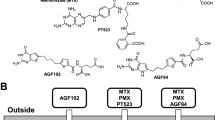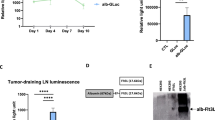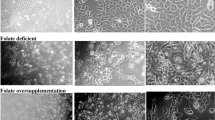Abstract
We previously reported that polyamidoamine STARBURST dendrimer (generation 3, G3) (dendrimer) conjugate with alpha-cyclodextrin (alpha-CyD) having an average degree of substitution of 2.4 of alpha-CyD (alpha-CDE) provided remarkable aspects as novel carriers for DNA and siRNA. To develop novel alpha-CDE derivatives with tumor cell specificity, we prepared folate-appended alpha-CDEs (Fol-alpha-CDEs) and folate-polyethylene glycol (PEG)-appended alpha-CDEs (Fol-PalphaCs) with the various degrees of substitution of folate (DSF), and evaluated in vitro and in vivo gene transfer activity, cytotoxicity, cellular association and physicochemical properties. In vitro gene transfer activity of Fol-alpha-CDEs (G3, DSF 2, 5 or 7) was lower than that of &x03B1;-CDE (G3) in KB cells, folate receptor (FR)-overexpressing cancer cells. Of the three Fol-PalphaCs (G3, DSF 2, 5 or 7), Fol-PalphaC (G3, DSF 5) had the highest gene transfer activity in KB cells. The activity of Fol-PalphaC (G3, DSF 5) was significantly higher than that of alpha-CDE (G3) in KB cells, but not in A549 cells, FR-negative cells. Negligible cytotoxicity of the pDNA complex with Fol-PalphaC (G3, DSF 5) was observed in KB cells or A549 cells up to a charge ratio of 100/1 (carrier/pDNA). The cellular association of the pDNA complex with Fol-PalphaC (G3, DSF 5) could be mediated by FR on KB cells, resulting in its efficient cellular uptake. Fol-PalphaC (G3, DSF 5) had higher binding affinity with folate binding protein (FBP) than alpha-CDE (G3), although the physicochemical properties of pDNA complex with Fol-PalphaC (G3, DSF 5) were almost comparable to that with alpha-CDE (G3), although the onset charge ratio and the compaction ability of Fol-PalphaC (G3, DSF 5) were slightly different. Fol-PalphaC (G3, DSF 5) tended to show higher gene transfer activity than alpha-CDE (G3) 12 h after intratumoral administration in mice. These results suggest that Fol-PalphaC (G3, DSF 5), not Fol-alpha-CDEs, could be potentially used as a FR-overexpressing cancer cell-selective DNA carrier.
Similar content being viewed by others
Article PDF
Author information
Authors and Affiliations
Corresponding author
Rights and permissions
About this article
Cite this article
Hirayama, F., Uekama, K., Arima, H. et al. Potential Use of Folate-polyethylene glycol (PEG)-Appended Dendrimer (G3) Conjugate with alpha-Cyclodextrin as DNA Carriers to Tumor Cells. Nat Prec (2011). https://doi.org/10.1038/npre.2011.6488.1
Received:
Accepted:
Published:
DOI: https://doi.org/10.1038/npre.2011.6488.1



